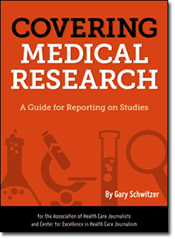Courtesy of the International Agency for Research on Cancer’s press release and the storm of advance coverage it has spawned, you’re probably already braced for Lancet‘s imminent publication of the IARC’s report classifying “radiofrequency electromagnetic fields” as “possibly carcinogenic to humans,” otherwise known as the cell phone/cancer link.
While you’re waiting, it’s worth taking a few minutes to put yourself in position to critically evaluate the study. The six-page press release is a decent place to start, but as Dr. Len Lichtenfeld, blogger and deputy chief medical officer for the national office of the American Cancer Society, reminds us, IARC is a respected source, but the science they’re reviewing is tricky and, at this point, it’s just a press release.
For background on the scientific debate, see Lichtenfeld’s commentary and Eliza Barclay’s post on Shots, NPR’s health blog.
If you don’t have time for the full press release right now, I have pasted what I consider the two must-read paragraphs below. The first summarizes what the working group found upon reviewing established science, while the second explains exactly how the scientists are currently classifying the possible link between cell phones and cancer. Between the two of them, you get a quick snapshot of the study and its implications.
Results
The evidence was reviewed critically, and overall evaluated as being limited among users of wireless telephones for glioma and acoustic neuroma, and inadequate to draw conclusions for other types of cancers. The evidence from the occupational and environmental exposures mentioned above was similarly judged inadequate. The Working Group did not quantitate the risk; however, one study of past cell phone use (up to the year 2004), showed a 40% increased risk for gliomas in the highest category of heavy users (reported average: 30 minutes per day over a 10‐year period).
Group 2B: The agent is possibly carcinogenic to humans.
This category is used for agents for which there is limited evidence of carcinogenicity in humans and less than sufficient evidence of carcinogenicity in experimental animals. It may also be used when there is inadequate evidence of carcinogenicity in humans but there is sufficient evidence of carcinogenicity in experimental animals. In some instances, an agent for which there is inadequate evidence of carcinogenicity in humans and less than sufficient evidence of carcinogenicity in experimental animals together with supporting evidence from mechanistic and other relevant data may be placed in this group. An agent may be classified in this category solely on the basis of strong evidence from mechanistic and other relevant data.
For more perspective on what a 2B classification really means, see Katherine Harmon’s post on the Scientific American editors’ blog. Her key point is that “The May 31 announcement, however, doesn’t imply that cell phones cause cancer. It suggests that there are still enough unknowns not to rule out long-term health effects of the devices.”
Merrill Goozner expects the evidence to be murky and he concludes that IARC’s tenuous conclusion will be fully justified but also largely ignored by the public. He also points us to Lou Slesin’s Microwave News for solid reporting on the conflicts of interest surrounding the issue.
Finally, once the science is published and it’s time to file stories, be sure to refer to AHCJ’s guide to covering medical studies (membership required), where you’ll find all the tips and reminders necessary to ensure you’ve covered all the bases on this high-profile story.
Online guide focuses on covering medical studies
Reporters are inundated with lures to cover the latest medical study or scientific conference paper. And there are some significant milestones being reached in medical research. But, more often, the information reaching the public is way too preliminary or even misleading, say those behind a new AHCJ reporting guide on covering health studies.
The guide will help journalists analyze and write about health and medical research studies. It offers advice on recognizing and reporting the problems, limitations and backstory of a study, as well as publication biases in medical journals and it includes 10 questions you should answer to produce a meaningful and appropriately skeptical report. This guide, supported by the Robert Wood Johnson Foundation, will be a road map to help you do a better job of explaining research results for your audience.






